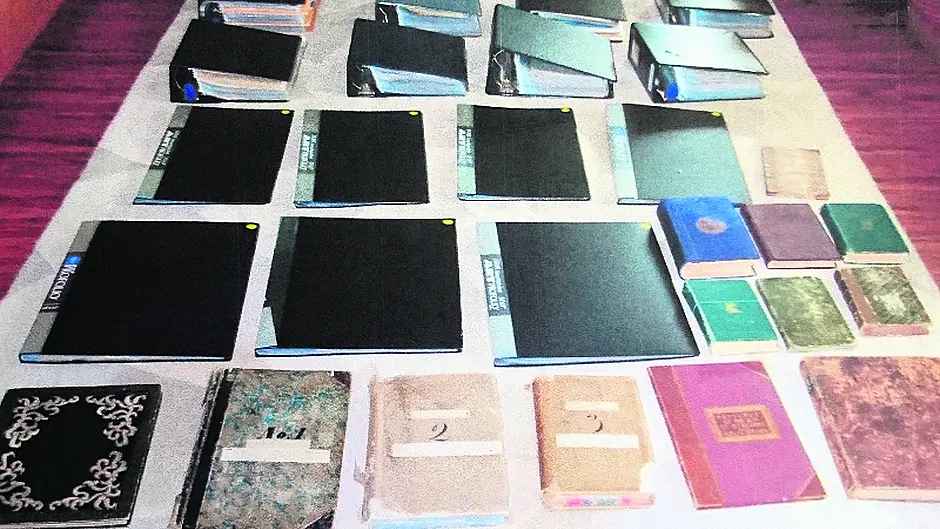The discovery of a valuable collection of historical documents spanning over 200 years has culminated in a weekend of celebration for one West Cork clan, writes Siobhán Cronin
The discovery of a valuable collection of historical documents spanning over 200 years has culminated in a weekend of celebration for one West Cork clan, writes Siobhán Cronin
DUNMANWAY is going MacCarthy mad this weekend.
The town, in one of the heartlands of the Irish McCarthy clan, will open its arms to visitors from across the globe who all have one thing in common: their surname.
‘At the 2013 MacCarthy Gathering, we were talking about the plaques at the back of St. Patrick’s Church in Dunmanway, but nobody knew where they had come from,’ explained UCC history lecturer and Dunmanway native Dr Mervyn O’Driscoll, addressing a public meeting last week.
The meeting had been called to inform the people of the town about the upcoming weekend, and the ‘backstory’.
Mervyn and his wife Michelle O’Mahony, a fellow author and historian, have both found themselves ensconced in research on the MacCarthy family name.
But it was questions about the church plaques which prompted this unlikely genealogy journey, culminating in this weekend of festivities.
To cut a long but fascinating story short, the plaques were discovered to have been donated to the church in 1872 by the author and philanthropist Daniel MacCarthy Glas – the ‘Glas’ differentiating this branch of the MacCarthys from others in the region.
Daniel’s family had emigrated from Dunmanway in the 1700s and ‘made good’ in coal and shipping. Daniel (1807-1884) married a British admiral’s daughter.
He wrote historic novels, but another element of his writing was the genesis for this weekend’s collaborations.
He left behind him two trunkloads of documents – 2,000 in all – which purported to be a historical and socilogical study of Ireland and England (and further afield) of his time.
Meticulously documented, including oral histories which were dated and collated into several notebooks, the wonderful treasure trove of research was – until now – in the hands of Daniel’s descendants, Don and his sister Susan MacCarthy, in Oregon, USA.
The family contacted a UK-based genealogist, Nigel McCarthy who, in turn, contacted Michelle and Mervyn
‘When we first started talking about these documents, people were very sceptical,’ explained Mervyn.
But the couple persisted, knowing the value of their cache, and eventually the documents were authenticated.
And now they are coming home.
‘Susan and Don wanted the documents to be repatriated to Cork,’ said Mervyn. ‘They could have sold them for quite a lot of money because many US universities would have loved to get their hands on them.’
The documents, including several hundred letters, showed rigorous research by Daniel MacCarthy over a period of 30 to 40 years. Among them, it was revealed that one of Daniel’s many well-known friends and correspondents was Denis Florence MacCarthy. Denis was a poet and a Young Irelander, who wrote in Thomas Davis’ The Nation. Denis supported Daniel O’Connell’s bid to repeal the Act of Union and his romantic poetry inspired WB Yeats. (In fact one or the two myths and legends that were to be later published in Yeats’ Fairy and Folk Tales of Ireland are mentioned in some of the MacCarthy documents).
The documents also solved a long-time mystery in Dunmanway: they contained very detailed records about the origins of the church plaques, which had been taken down from inside St. Patrick’s in the 1940s or 1950s. They were placed on the external rear wall by the pure good fortune that a local MacCarthy intervened to prevent them from being discarded during church renovations.
‘People thought they were a monument put up by an Englishman and so there wasn’t much value put on them at the time,’ Mervyn admitted.
But what many locals didn’t realise was that Daniel MacCarthy Glas, although married into a Church of England family, stayed loyal to his own Catholic upbringing, and had his children brought up in his own faith.
MacCarthy also gave generously to many causes in Dunmanway and educated many children who would not otherwise have received an education.
‘In letters, he is asking the parish priest “how much to get so-and-so educated” and there are letters from the priest thanking him for sponsoring named children,’ said Michelle. ‘There were donations to the church for its upkeep and he also sent the local priest a library of history books.’
After lengthy negotiations between Michelle, Mervyn, the Cork City and County Archive, and the family in Oregon, Cork Archive agreed to house the collection, and have been creating an inventory of them in recent months.
The Cork City and County Archive is funded by Cork City and County Councils, and UCC. It is accessible to the public.
While the collection itself will be maintained at the Cork City and County Archive, it has been agreed that certain elements will be copied and then made available in the Dunmanway Historical Association’s centre at Atkins Hall in the town. Tim O’Donovan, chairperson of Dunmanway Historical Association, said: ‘We look forward to helping MacCarthy’s from all over the world.’
Michelle explained that having a presence in both places means that people visiting the archives can be directed to Dunmanway, and vice versa.
Included in the documents are also the writings of Daniel’s family – from a son who went to India, another who left detailed accounts and drawings of the Zulus and Afrikaners of South Africa, and Tasmania.
Daniel had three grand-daughters who all became nuns, with links to St John’s Wood in London. One of the last letters from the nuns is to a brother in Oregon giving an account of of Zeppelin air ships bombing London during WWI. Perhaps the collection made its way to the US for safekeeping, Michelle noted.
‘UCC academics are extremely excited about this because there is something in it for everyone,’ said Mervyn. Professor David Ryan, Chair of Modern History, UCC is delighted. He believes this is a great resource that will benefit many Irish historians, university students and local historians.
There are also early maps of ‘Hibernia’, including a rare copy of the 1567 map by John Goghe.
Events during the MacCarthy weekend – which will be based at the Parkway Hotel in Dunmanway – feature a talk on the MacCarthy DNA project, tours of the relevant sites in the area, many talks including one on the family’s links to Castle Salem in Rosscarbery, and a reception including wine from the Chateau MacCarthy vineyard in Bordeaux.
Guests will include several well-known Mac/McCarthys. There will be 30-40 Americans and Canadians coming over for the weekend, having discovered roots in Cork (and some in Kerry).
The town will be putting on local entertainment for their guests, separate to the events, talks and tours organised by the committee.
Local businesses and shops are being asked to join in the fun for the weekend, by displaying any McCarthy items, memorabilia, crests, flags or welcome signs, in their windows. ‘We are hoping Dunmanway will put on a good show for the weekend, as they always do, and give our visitors a weekend to remember,’ said Mervyn.
How Andrew found his family – with a little West Cork help
NIGEL McCarthy is the man behind the MacCarthy Surname Study, which has unearthed some hugely significant connections for the original clan.
Nigel’s interest in DNA was first piqued in 2008, when he attended a talk on the subject at the ‘Who Do You Think You Are’ show in London. ‘Prior to that I had pursued paper-trail genealogy research for 30 years. A Y-DNA test was the last throw of the dice in my attempt to find paternal ancestors of my Co Cork McCarthys who had arrived in East London, probably in the first decade of the 19th century,’ he told The Southern Star.
The McCarthy Surname Study was started by (unrelated) Americans Barbie Ann McCarthy and Cliff McCarthy in 2002. Barbie Ann visited Dunmanway, recruiting McCarthys in 2003. They subsequently passed the reins to another American gentleman. However, by 2010, the project had been dormant for over five years and Nigel was invited to become involved. Today, the project has 326 members, who have discovered their routes via a simple DNA kit.
Nigel explained how the DNA element of the study works:
‘You take a swab of the inner cheek, using a kit provided by the testing company, and post it off. Its laboratory carries out the analysis and posts the results with a modicum of interpretation. This project is primarily concerned with Y-DNA, and for this I provide a more detailed interpretation and am usually able to place the participant on an appropriate tree tracing his lineage from about 4,500 years ago to the present day.’
The project has collated some wonderful results. ‘The paternal origin of the MacCarthy kings of Cashel and Desmond, prior to the 10th century, is not what the ancient genealogies, any Irish histories, or Wikipedia sites tell us,’ said Nigel. ‘Instead of O’Sullivan, O’Keeffe, O’Donoghue, O’Mahony and O’Moriarty, it is shared with present-day surnames like Chisholm, Eubank(s), Higgins, Kennedy and Leahy and Lyons.
The UK-based genealogist says there has been a greater interest in autosomal DNA testing due to advertising on TV. Autosomal testing matches up both male and female ancestry over the past four-six generations. ‘However the ‘new join’ rate testing for Y-DNA – for males only – and which thus follows the surname in a patrilineal society such as ours, has remained steady,’ he pointed out.
Nigel said that accuracy hasn’t actually improved with time. But what has improved steadily from 2001 to 2014 is the scope of Y-DNA testing, providing more data for analysis. ‘Then the introduction of Next Generation Sequencing in 2014 provided a major step change in our ability to analyse the Y-chromosome.’
When Nigel tested his own DNA, he said there were few surprises. ‘I was open-minded about it. I found a lovely family in West Cork with whom I share paternal ancestry around 1600. However, our particular line was certainly once that of O’Regan, of an origin almost certainly in the 9th century Riacán of the Uí Fhidgeinte peoples, closely related in those days to the O’Donovans-to-be. Here was another surprise. Several histories tell us that most Munster O’Regans descend from a nephew of Brian Boru(mu). But there is no genetic evidence at all for this.’
Research has led Nigel to estimate there are about 230,000 McCarthys currently alive.
One of those – Hollywood 80s heart-throb Andrew McCarthy came to Nigel to help him pinpoint his 19th century Co Kerry origins. Andrew wrote about his experience in a National Geographic special in 2015, but after that, Nigel lost contact with the actor-turned-travel writer.
Michelle O’Mahony says she would love to know if other prominent McCarthys, like Sean Spicer mimic Melissa McCarthy, have had their DNA tested. Imagine the fun we would have if we found Melissa’s family came from the same Irish county as Sean Spicer’s?!









